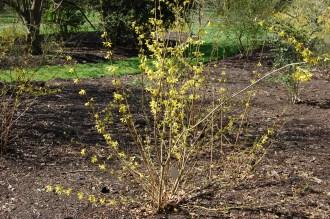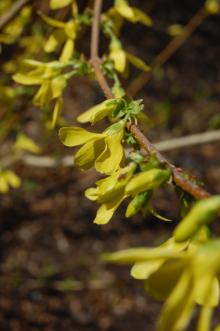
Forsythia suspensa var. fortunei (21/04/2013, Kew Gardens, London)
Position: Full sun to partial shade
Flowering period: Spring
Soil: Moist, well drained
Eventual Height: 3m
Eventual Spread: 3m
Hardiness: 5a, 5b, 6a, 6b, 7a, 7b, 8a, 8b, 9a
Family: Oleaceae
Forsythia suspensa var. fortunei is a deciduous spring flowering shrub with an upright, weeping habit. Its mid green leaves are ovate to lanceolate with serrate margins, up to 8cm long and 5cm wide. The yellow, four lobed flowers are located singularly in the leaf axils, are up to 3cm across, are lightly scented and appear before the leaves. Its fruit is a dry, ovoid capsule, contain winged seeds and appear in late summer. Its branches may root where they touch the ground.
The species Forsythia suspensa, commonly known as Weeping Forsythia, is native to central east China. In its native habitat it grows in thickets or grassy areas on slopes. This shrub has been used in Chinese medicine for at least 4000 years.
The etymological root of the binomial name Forsythia is named after William Forsyth (1737-1804), the superintendent of the Royal Gardens in Kensington and St. James Palace and founder member of the RHS. Suspensa is derived from the Latin suspendium meaning ‘hanging’. Fortunei is derived from the name of Robert Fortune, the Scottish botanist and traveler best known for introducing tea plants from China to India, back in the 19th century.

Forsythia suspensa var. fortunei Flower (21/04/2013, Kew Gardens, London)
The landscape architect may find Forsythia suspensa var. fortunei useful as a spring flowering shrub. It is suitable for use as a shrub for training against walls. This shrub is not attractive to deer.
Ecologically, Forsythia suspensa var. fortunei flowers are attractive to pollinating insects.
Forsythia suspensa var. fortunei prefers moist, fertile, well-drained soils. It tolerates most pH of soil.
Forsythia suspensa var. fortunei requires little maintenance. If required, pruning should be carried out after flowering.

